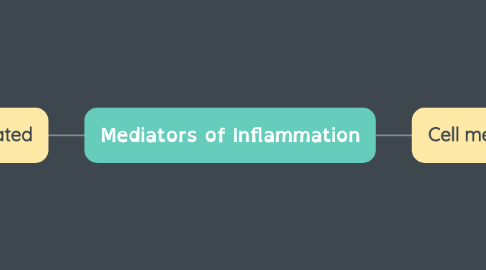
1. Cell mediated
1.1. Vasoactive amines
1.1.1. Histamine
1.1.1.1. It is a preformed vasoactive mediator. Responsible for an immediate transient response. Source: Mast cells (richest source), blood basophils and platelets. Stimuli: Physical injury; immune rxn; chemical mediators. Actions: Dilation of arterioles and increase of vascular permeability.
1.1.2. Secretonin
1.1.2.1. (5-hydroxytryptamine): It is a preformed vasoactive mediator. Source: Platelets, some neurons and enterochromaffin cells in the gastrointestinal tract. Stimulus: Platelet aggregation and antigen-antibody complexes. Actions: Similar to those of histamine.
1.2. Arachidonic Acid
1.2.1. Prostaglandin
1.2.1.1. Mechanism: They are produced from AA by the actions of two cyclooxygenases, COX-1 and COX-2.
1.2.1.2. Local effects: TxA2: Vasoconstriction and promotes platelet aggregation; Prostacyclin (PGI2): Vasodilator and inhibits platelet aggregation; PGD2 and PGE2: Vasodilation and increased permeability. PGD2 is also a chemoattractant for neutrophils.
1.2.2. Leukotrienes
1.2.2.1. 5-hydroxyeicosatetraenoic acid (5-HETE): Chemotactic for neutrophils, and is the precursor of the leukotrienes.
1.2.2.2. Systemic effects: Prostaglandins are responsible for pain and fever in inflammation. PGE2 causes
1.2.2.3. LTB4 – Chemotactic agent. Neutrophil activation causing adhesion to endothelium, generation of ROS, and release of lysosomal enzymes.
1.2.2.4. Leukotrienes C4, D4 and E4(LTC4, LTD4, LTE4) Vasoconstriction; Bronchospasm (in asthma); Increased vascular permeability.
1.2.3. Lipoxins
1.2.3.1. Actions: Inhibit inflammation. Inhibit neutrophil chemotaxis and recruitment. Inhibit leukocyte adhesion to endothelium.
1.3. Platelet activating factor
1.3.1. Action: Multiple inflammatory effects: Vascular reactions: Vasodilation and increased vascular permeability. Cellular reactions: Increased leukocyte adhesion to endothelium, chemotaxis.and Increases the synthesis of other mediators, mainly eicosanoids
1.4. Reactive Oxygen species
1.4.1. Cell of origin: Leukocytes (neutrophils and macrophages).
1.5. Actions: Physiologic function: ROS in leukocytes destroys phagocytosed microbes and necrotic cells. Pathological actions: Endothelial cell damage, which causes increased vascular permeability. Injury to other cells: For example, tumor cells, parenchymal cells and red blood cells. Inactivation of antiproteases, such as α1-antitrypsin, e.g. destruction of elastic tissues in emphysema of lung
1.5.1. Mechanism of production: Leukocytes during phagocytosis (after exposure to microbes, chemokines, and immune complexes) generate oxygen-derived free radicals
1.6. Nitric Acid
1.6.1. Nitric oxide (NO) is a soluble, free radical gas which causes vasodilation (was known as endothelium-derived relaxing factor).
1.6.2. Source: Many cells such as endothelial cells, macrophages and neurons in the brain. Synthesis: Synthesized from l-arginine, molecular oxygen, and NADPH by the enzyme nitric oxide synthase (NOS).
1.6.3. It acts in a paracrine manner on target cells. Vasodilatation by relaxing vascular smooth muscle cells. Controls inflammatory responses by inhibiting leukocyte recruitment and adhesion. Reduced platelet adhesion, aggregation and degranulation. Microbicidal activity
1.7. Cytokines
1.7.1. Tumor necrosis factor and IL-1
1.7.1.1. Source: Activated macrophages. Stimuli: Endotoxin and other microbial products, immune complexes, physical injury, and many inflammatory stimuli.
1.7.1.2. Action: Local effects: Endothelium: Endothelial activation and increased expression of endothelial adhesion molecules. Leukocytes: TNF increases the responses of neutrophils to other stimuli (e.g. bacterial endotoxin). During repair: Proliferation of fibroblasts and increased synthesis of collagen. Systemic effects: Fever
1.7.2. Chemokines
1.7.2.1. Chemotactic cytokines or chemokines are small proteins, which selectively attracts various leukocytes to the site of inflammation. Action: Chemotaxis of monocytes, eosinophils, basophils, and lymphocytes except neutrophils. They activate leukocyte and promote their recruitment to the sites of inflammation.
1.7.3. Others
1.7.3.1. IL-6 produced by macrophages and other cells is involved in local and systemic reactions. IL-17 produced by T lymphocytes promotes neutrophil recruitment
2. Plasma mediated
2.1. Complement Component
2.1.1. Pathways of complement system activation: The decisive step in complement activation is the proteolysis of the third component, C3.
2.1.2. 1. Classical pathway 2. Alternative pathway 3. Lectin pathway
2.1.3. Functions: Leukocyte activation, adhesion and chemotaxis; Opsonization and promote phagocytosis; Cell and bacterial lysis; Increased vascular permeability; Activation of AA; Defense against microbes through innate and adaptive immunity. Clearance of Immune complexes (Clq, C3) and Apoptotic cells (Clq, C3).
2.2. Kinins
2.2.1. Kinins are vasoactive peptides derived from plasma proteins.
2.2.2. Mechanism of production: Factor XII a converts pre-kallikrein to kallikrein, which in turn cleaves high molecular-weight kininogen to produce bradykinin.
2.2.3. Actions of bradykinin: Increases vascular permeability Pain when injected into the skin.
2.2.4. Actions of kallikrein: Potent activator of Hageman factor; Chemotactic activity: Directly converts C5 to the chemoattractant product C5a.
2.3. Coagulation or Fibrinolytic System
2.3.1. 1. Activation of fibrinolytic system: Factor XII a stimulates fibrinolytic system by converting plasminogen to plasmin.
2.3.2. 2. Activation of the Kinin system
2.3.3. 3. Activation of the alternative complement pathway: Factor XII a can activate alternate complement pathway
2.3.4. 4. Activation of the coagulation system: Factor XII a activates coagulation system and form thrombin, which has inflammatory properties.
